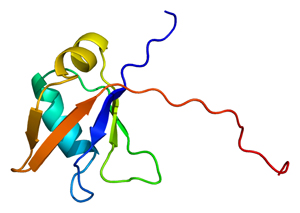
The splice of life. Researchers discovered that the protein TDP-43 (above) regulated the assembly or stability of more than 1000 RNAs in the center of the mouse brain. Image: Emw, Wikimedia Commons.
TDP-43 helps ensure proteins are produced appropriately by regulating the processing and translation of RNAs. But in over 90% of people with ALS, TDP-43 builds up in the cytoplasm of cells of the brain and spinal cord. The role of TDP-43 in ALS however remains controversial.
To try and figure out what role if any TDP-43 could play in the disease, researchers at the University of California at San Diego (UCSD) turned to crosslinking, immunoprecipitation and high-throughput sequencing (CLIP-seq) to obtain a comprehensive list of genes that may be regulated by TDP-43 in the brain.
The team found that nearly one third of all genes in the mouse brain may be regulated at least in part by TDP-43. And, within the center of the brain, more than 1000 RNAs required TDP-43 for appropriate assembly or stability.
The study is published this week in Nature Neuroscience.
In future, the UCSD scientists hope to identify a subset of these genes that may contribute to the onset or progression of ALS due to mislocalized TDP-43. These discoveries could inspire new therapeutic strategies for the disease.
Reference
Polymenidou M et al. (2006) Long pre-mRNA depletion and RNA missplicing contribute to neuronal vulnerability from loss of TDP-43 . Nature Neuroscience, 14(4), 459-468. Abstract | Full Text
Further Reading
Tollervey, J.R. et al. (2011) Characterizing the RNA targets and position-dependent splicing regulation by TDP-43. Nature Neuroscience, 14(4), 452-458. Abstract | Full Text